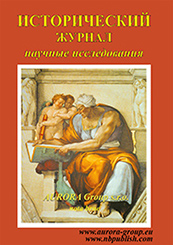Editor-in-Chief's column
Reference:
S.P. Karpov (2013). Russian Academy of Sciences
and its reforming projects. History magazine - researches, 4, 367–373. https://en.nbpublish.com/library_read_article.php?id=62999
Abstract:
the article describes the stages of development of the Russian Academy of Sciences and its reorganisation. The author concludes that the path
of development of the Academy of Sciences from 1747 to 1991 strengthened its internal structure and the potential of the Academy of Sciences in order
to create an optimal research environment and to advance the strategic interests of the country. The latest achievements of the RAS are discussed and the
performance criteria of scientific work, in particular - the world’s citation indexes, are reviewed. The RAS’s concept of the reorganisation of the Russian
Academy of Sciences which was submitted in 2013 to the State Duma as a draft federal law (DFL) is analysed in terms of the history of the Academy, its
traditions and the challenges it faces. Corrections which are addressing a number of provisions of the DFL are suggested, with a view to developing science
and the social and political situation, as well as ethical and legal norms of civil society.
Keywords:
History, Russian Academy of Sciences, the reforms scientometrics performance criteria of scientific work, the traditions, the federal law, civil society, competitive advantages, a national treasure.
Interdisciplinary research
Reference:
T.G. Skorokhodova (2013). Oriental knowledge in the humanities
education in Russia: Reflections
of the university teacher. History magazine - researches, 4, 374–381. https://en.nbpublish.com/library_read_article.php?id=63000
Abstract:
The article presents the reflections by a university teacher about the problems of Oriental achievements’ integration into the Modern humanitarian
education in Russia. The author sees the problem of teaching special humanities in a lag of course content from the latest developments of Russian
Oriental Studies, which remain the property of scholars and orientalists. The author cites the examples from their own pedagogical practice of teaching
sociological disciplines and shows the need for the integration of Oriental problems into the humanities courses, both a general and special cycle. In addition
to deepening knowledge of the socio-cultural reality and understanding their own country, oriental knowledge contributes to overall enlightenment
purposes, viz to overcome the negative stereotypes about other people, cultures and countries, to expand the horizons of thinking, to understand the Other,
as well as to understand of the universal and the particular in the development of Russia.
Keywords:
history, oriental studies, sociology, science, education, Russia, East, tradition, modernization and education.
Historical facts, events, phenomena
Reference:
A.S. Stepanov (2013). The corruption in the aviation
industry of the USSR
in the 1930’s - early 1940’s. History magazine - researches, 4, 382–394. https://en.nbpublish.com/library_read_article.php?id=63001
Abstract:
The situation in the aviation industry of the USSR in 1930 is analyzed. The author reviews the documents from the various departments and
discovers the numerous cases of corruption in this area at the time. Still barely developed in the national historiography, this subject reveal the appearance
of the”vertical” connections and “horizontal” connections based on the clan principle in the rigid centralized command-and-control systems.
Keywords:
history, aviation, industry, designer, engineer, corruption, clan, nepotism, the NKVD, the People’s Commissariat.
FACTORS OF HISTORICAL PROCESS
Reference:
V.G. Khandorin (2013). Kolchak and “Finnish question”. History magazine - researches, 4, 395–404. https://en.nbpublish.com/library_read_article.php?id=63002
Abstract:
The paper investigates the issue of the negotiatiations of the White Kolchak Government with Finnish authorities about the military assistance
in 1919. The aim of work is to clarify the course of the events and the reasons for the unsuccessful outcome of the negotiations. The article presents new
archival documents that provide insights on the history of negotiations. The documents did not support the version of the “anti-national policy” of the
White movement, and reveal the viable reasons for the refusal of Kolchak in meeting the demands of Finland. Cited documents confirm the stable greatpatriotic
standing of A.V. Kolchak and the other top leaders of the White Guard in the Finnish question and in view of the national question as a whole.
The documents reveal that the objective reasons for denying the demands of Finland were the absence of the guarantees of military support from Finland
in addition to the political risks in a complex political environment. The results of this paper can be used in reviewing works on the history of the Russian
Civil War, the White movement in Russia and Siberia.
Keywords:
Russian history, the Civil War, the White movement, Finland, the national question, foreign policy, A.V. Kolchak, G. Mannerheim, N. N. Yudenitch, S.D. Sazonov.
Personality in history
Reference:
M.V. Frolova (2013). The Grandee of the Enlightenment:
Lieutenant-General V. Chertkov. History magazine - researches, 4, 405–418. https://en.nbpublish.com/library_read_article.php?id=63003
Abstract:
The paper explores the career of V.A. Chertkov (1726-1793), a graduate of the Czlachta Cadet corps. He was appointed a professor of engineering,
artillery and fortification of Arts and a cadet commander of an artillery company, which was attached to the corps. He ran the corps printing press
from the day it started in 1757, he was a member of the censorship committee at the printing house, and was one of the editors of the first private, Russian
weekly magazine “Prazdnoe vremja v pol’zu upotreblennoe” (Idle time spent with benefit). He was deported by Catherine II from St. Petersburg to Novorossija,
where he built fortresses and cities. In the fortress of St. Elizabeth he set up a printing house, where the “Russian alphabet” and “House Cafe” were
printed (a V.A. Chertkov translation of the J. Rousseau comedy was staged in 1770, during the Russian-Turkish war of 1768-1774, in Yelisavetgrad). After becoming the governor of Voronezh and Saratov provinces, he actively implemented the reform of 1770-1780 years. Chertkov remained faithful to the
ideas of the Enlightenment on all the occupied posts: he was involved in organizing print shops, a theater, a school and a hospital as well as publishing
the magazine.
Keywords:
History, V.A. Chertkov, Czlachta Cadet corps, A.P. Melgunov, fortress of St. Elizabeth, “Cafe House”, Voronezh, the governor of Voronezh, theater, education, Chertkov library.
Social history
Reference:
Yang Zhe (2013). History of the Trade Unions
of the USSR and Russia in the works
of Russian and Chinese historians. History magazine - researches, 4, 419–427. https://en.nbpublish.com/library_read_article.php?id=63004
Abstract:
The article studies the trade unions - the most influential non-governmental organizations in the Soviet Union and Russia. In the USSR, these
organizations have performed many historically important tasks. In post-Soviet Russia the trade unions were transformed in order to develop them along
with the changes in society. As in Russia, the social basis of China is multi-millions of workers who go though the stage of the social transformation. For
this reason, the study of the transformations of the Trade Unions in Russia and the analysis of the experience of these changes are of great importance for
China. This paper provides an overview of the Russian and Chinese historiography - research on the history and trends of the Trade Unions of the USSR
and Russia.
Keywords:
history, Russian historiography, Chinese historiography, society, working class, the government, trade unions, the Soviet Union, Russia, social transformation.
Regions of the world in the global historical process
Reference:
A.V. Pakin (2013). Shiva Pilgrimage of 1536 and the
conquest of Yucatan: version of the
episode of the later Maya history. History magazine - researches, 4, 428–439. https://en.nbpublish.com/library_read_article.php?id=63005
Abstract:
The article focuses on one of the key episodes in the history of late Yucatec Maya, the extermination of the nobility of one of the most powerful
dynasties of Yucatan Shiva by their old foes from Kokomo family. The historians of the Conquest, considered that this was the main reason that led them
to the Spanish camp and that it allowed the Spanish conquistadors to finally conquer the peninsula after the two failed attempts. In the study of this
episode, little attention was paid to the source research aspects. Existing versions contain different dates of the incident, the participants and the aim
of the pilgrimage. Analysis of the versions preserved in written early colonial sources using a simple cross-criticism shows that they actually date back to
the injured party, that is, Shiva, where the description of the event in a short time transformed into the description of the alleged embassies of Shiva to
the Spaniards, reports of which have been taken for granted by historians of the major conquest (R. Chamberlain, V.I. Gulyaev). These sources reflect
the views of the interested party. Recent studies of the sources O. Harada and T. Hillerkyussa show how easy it was for the authors to manipulate the
facts. Documents created by the Indian authors after the Conquest are written in the “loyalist” spirit and distort or do not mention the facts, which are
improper from the point of view of the morality and culture of the conquerors (such as the pagan cults). These researchers suggested that the attitude
to the Spanish conquerors did not depend on the relationship of the local rulers against the overall fragmentation of the polities of Yucatan. The fatal
nature of the episode with the extermination of pilgrims in Otsmale is exaggerated by the historians. The Shiva dynasty actively sought an alliance with
any force hostile to Kokomo, and this was one of the hidden purposes of the “pilgrimage”. The results of this study reassess some of the key episodes of the
Yucatan conquest .
Keywords:
history, conquest, Yucatan, embassy, Maya, post-classics, Shiva, Kokomo, the colonial regime, the Mayan calendar, Otsmal, kuchkabal.
Culture and cultures in historical context
Reference:
O.G. Gerasimova (2013). VGIK (All-Russia State Institute
of Cinematography) as cinema
stock production.
The 1950-1960-ies. History magazine - researches, 4, 440–456. https://en.nbpublish.com/library_read_article.php?id=63006
Abstract:
The paper attempts to examine the unique life of students of the Soviet school during the “thaw.” With help of the archival documents (most of
which are being introduced into the scientific circulation for the first time), memoirs, newspaper and magazine articles and interviews, the author recreates
a picture of the difficult and sometimes dramatic situation in VGIK, when for telling a joke or hosting a home concert party students could be arrested,
expelled from the institute and their diploma film works exposed to harsh criticism or failure. In the country as a whole, and in the film industry in particular,
there was a unique situation. On the one hand, since March 1953, and especially after the Twentieth Party Congress, there appeared a certain amount
of freedom, on the other there remained tight control. Despite the ideological dictates, in the 1950-1960-ies there were films made that largely determined the
creative direction of their creators: students and graduates of VGIK, who later created the “gold” fund of the national cinema.
Keywords:
history, the “thaw” of the XX Congress, students, VGIK, ideology, party meeting, the Komsomol, the search for novelty, freedom of creativity.
ECONOMIC HISTORY, ENTERPRENEURIAL HISTORY
Reference:
I.V. Shilnikova (2013). Punishment as an element
of incentive system for textile
workers in Soviet Russia (1918-1929):
microanalysis. History magazine - researches, 4, 457–471. https://en.nbpublish.com/library_read_article.php?id=63007
Abstract:
The article describes the main measures that were used for stimulation of the labour of textile workers in the first decade of the Soviet regime. The methodology
of the study is based on a versatile approach, developed by researchers at the International Institute of Social History (Amsterdam); it has been repeatedly
and successfully applied in Western and Russian studies. In accordance with this approach, the classification of the worker labour intensives includes three
categories: 1) the remuneration (salary, bonuses, benefits and various forms of social security, etc.), 2) coercion (monetary, administrative, including criminal
liability), 3) motivation (related to employee awareness of the importance and usefulness of the work, patriotism, pride results etc.). In this paper, we review a
second category of incentives that relies on coercion and involves the use of various forms of punishment (or the threat of punishment) to maintain the proper
level of discipline and productivity. The study is based mainly on documents from the central and regional archives, which allowed us to combine the principles
of micro-and macroexamination. The objects of the microanalysis were individual large textile factories. The real work practices that reflect the mechanisms for
motivating textile workers were studied on the basis of the comprehensive documentation of the archives of the industrial factories. The study of processes at micro
level (case studies) was conducted taking into the account the nature of the processes taking place in the Soviet industry as a whole.
Keywords:
history, economic history, Soviet Russia, War Communism, NEP, stimulation of labor, the textile industry, enforcement, labor discipline, codisciplinary courts, the system of penalties.
REVIEWS, BIBLIOGRAPHY
Reference:
A.I. Golovlev (2013). Scalene triangle?: Kemalist Turkey,
fascist Italy, and the USSR
in the Stalin period under
comparative analysis. History magazine - researches, 4, 472–475. https://en.nbpublish.com/library_read_article.php?id=63008
Abstract:
The article explores the monographic study of Professor. Pc. Plaggenborg which is dedicated to the comparative analysis of fascist Italy, Kemalist
Turkey and Bolshevik Russia (USSR) during the period between the World Wars. The reviewer examines the methodology and structure of this work, while
pointing out the scientific novelty of a comparative approach within the suggested “triangle” of countries, and provides detailed critique of some of the
author’s positions. The critic positively regards the author’s research of how each country viewed the others, as well as the study of the works of analysts
and little-known Soviet turkologists. The critic outlines the precision and appropriateness of a comparative analysis of the preconditions for the emergence
of the three regimes - the backgrounds of the ruling elites, representation of authority, the growth of the oppression mechanisms and the relations between
authority and religion. Other theses seem less persuasive – the essay on the post-war history of Italy, Turkey and USSR appears incomplete, and the research
of the economy of the three countries is not deep enough. Moreover, the place of the studied countries in the greater global political picture is not given
enough attention, which further reduces the complicity of the analysis. Overall, the monography is regarded as broad research that unveils new horizons
and provides perspective for further comparative research in a refreshed interdisciplinary format, its scientific relevance and significant importance, as
well as its conclusions are highly regarded by the scientific community.
Keywords:
history, USSR, Italy, Turkey, fascism, socialism, dictatorship, comparative history.
 This work is licensed under a Creative Commons Attribution-NonCommercial 4.0 International License.
This work is licensed under a Creative Commons Attribution-NonCommercial 4.0 International License.
 Eng
Eng












 © 1998 – 2025 Nota Bene. Publishing Technologies. NB-Media Ltd.
© 1998 – 2025 Nota Bene. Publishing Technologies. NB-Media Ltd.




